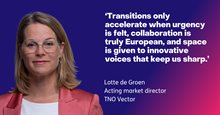Broad prosperity as a new paradigm

Diana Vonk Noordegraaf: Broad prosperity is comprehensive. Human well-being is central to broad prosperity. Broad prosperity transcends financial or material prosperity. Moreover, it takes into account not only the situation in the here and now, but also the dimensions elsewhere and later. There is also a focus on equity and social inclusion. It gives room for explicit or different choices and widens the playing field of solutions.
Broad prosperity is therefore not just a new economic movement, but a much broader social change. Several transitions call for more attention to redesigning society and its institutions. We know that with the increasing scarcity of resources and the growing scale of social tasks, difficult choices lie ahead. This requires a clear, integrated vision and direction, and raises philosophical questions: Which tasks need to be tackled? Which are the most urgent? How do we make choices? What is social progress and for whom?
In this article, I reflect on how broad prosperity is not just about the economy, but also about our humanity, society, the planet, and the role of government. I also reflect on how fundamentally different the broad prosperity paradigm may be compared to the current paradigm. Paradigm refers to the lens through which we see and think about the world, and how this affects our decisions. In this sense, broad prosperity is not a current paradigm – and certainly not the dominant paradigm.
Common complaints about the current paradigm include the pervasiveness of market thinking, major concerns about crossing planetary boundaries, and the too limited task the Netherlands sets itself to be sustainable, concerns about growing inequality (such as the fact that people at the top of the welfare ladder live almost 25 years longer in good health), and people dropping out of society.
The current paradigm is everywhere, which means that broad prosperity is still rowing against the tide. Putting broad prosperity into practice still requires a great deal of effort because, for example, information for decision-making is incomplete (e.g. information on people’s perceptions and experiences is often lacking), procedures and budgets are siloed, attention needs to be paid to white spots in policy (e.g. on distributional effects within and between groups), and change is also complex for policymakers. Interpreting the current paradigm could perhaps provide inspiration for what a broad prosperity paradigm might look like. Ideas for developing a new paradigm are also already emerging.
In the table below, I make a preliminary attempt at interpreting and comparing the current paradigm and a possible broad prosperity paradigm. I use archetyping to do this. In practice, there are already shifts in the current paradigm and more and more new elements are being added.
| Current paradigm | Towards a new broad prosperity paradigm | |
|---|---|---|
| Human image | Homo economicus focused on individual need satisfaction. | The connected and resilient human. |
| Society | Globalised consumer society. | Supranational network society. |
| Planet | (Exponential) exploitation of resources (oil and gas) with underestimation of the planetary consequences. | Consideration of planetary boundaries. |
| Government | Government focused on market efficiency and effectiveness (neoliberalism). | Inviting, balanced (two-legged) government, inclusive, bottom-up, focused on public value creation, accountability, and resilience. |
| Economy | Free market economy aimed at increasing material wealth, with GDP as the main indicator, sometimes also referred to as the fossil fuel economy. | Value-creation economy focused on different forms of wealth (material, social, institutional, cultural) with a broad set of indicators. |
What does it take to shape broad prosperity as a paradigm? In any case, a systems perspective is needed to look at the challenges and their interactions, such as how electric driving will impact mobility, energy, and housing. The table above also shows the value of ‘transdisciplinary work’; we need knowledge from multiple disciplines, such as philosophy, psychology, sociology, sustainability studies, public administration, political science, and economics. But most importantly, we need optimism and imagination as the antidote to the paralysis and sense of hopelessness that come with the complexity of broad prosperity and the slow pace of change. Climate scientist and Nobel laureate Gupta puts it well: ‘Things can change, including overnight. Maybe working until then is a pleasant distraction.’ So let’s literally work to make broad prosperity a reality.
At TNO, we work to provide governments with action perspectives, roadmaps, trade-off frameworks, and impact analyses to make broad prosperity a reality. If you have ideas about what a new paradigm might look like, or would like to know more about how to make broad prosperity work in policy practice, please contact us.



